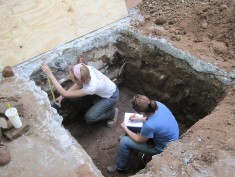Home / Education
Ideas for Teachers
Archaeology is fun and informative and can be used in the classroom in multiple ways. Students can examine and describe objects using basic scientific methodologies. Artifacts can illuminate history, art, technology, social studies, and many other lessons including statistics, geometry, and measuring. Finally, archaeology can also develop critical thinking and improve students' abilities to read and write expository works. This website describes New York City's sites and artifacts and includes high resolution images and site reports that narrate what was found and what was learned about the city's past. This information can highlight the lives of everyday people who once touched these artifacts and will help place the artifact in historical, economical, and technological context. It may also be used as part of the Common Core as explained in the accompanying essay by Philip Panaritis, Senior Borough Instructional Lead in Social Studies for the NYC-DOE Bronx Field Support Center.
All information on this website is public and may be downloaded to illustrate lessons or create class projects. For example, artifact images could be downloaded and then students may be asked to describe them using some of the following exercises. This site welcomes and will post helpful curriculum submissions and suggestions that utilize the city's heritage and will gladly give the creators credit.
Suggested websites with lesson plans:
Suggested overviews about New York City Archaeology:
- Nan Rothschild, Amanda Sutphin, H. Arthur Bankoff, and Jessica Striebel MacLean, Buried Beneath the City: An Archaeological History of New York (Columbia University Press), 2022.
- Anne Marie Cantwell and Diana diZerega Wall, Unearthing Gotham: The Archaeology of New York City (Yale University), 2001.
- Diana diZerega Wall and Anne Marie Cantwell, Touring Gotham's Archaeological Past: 8 Self-Guided Walking Tours Through New York City (Yale University), 2004.


